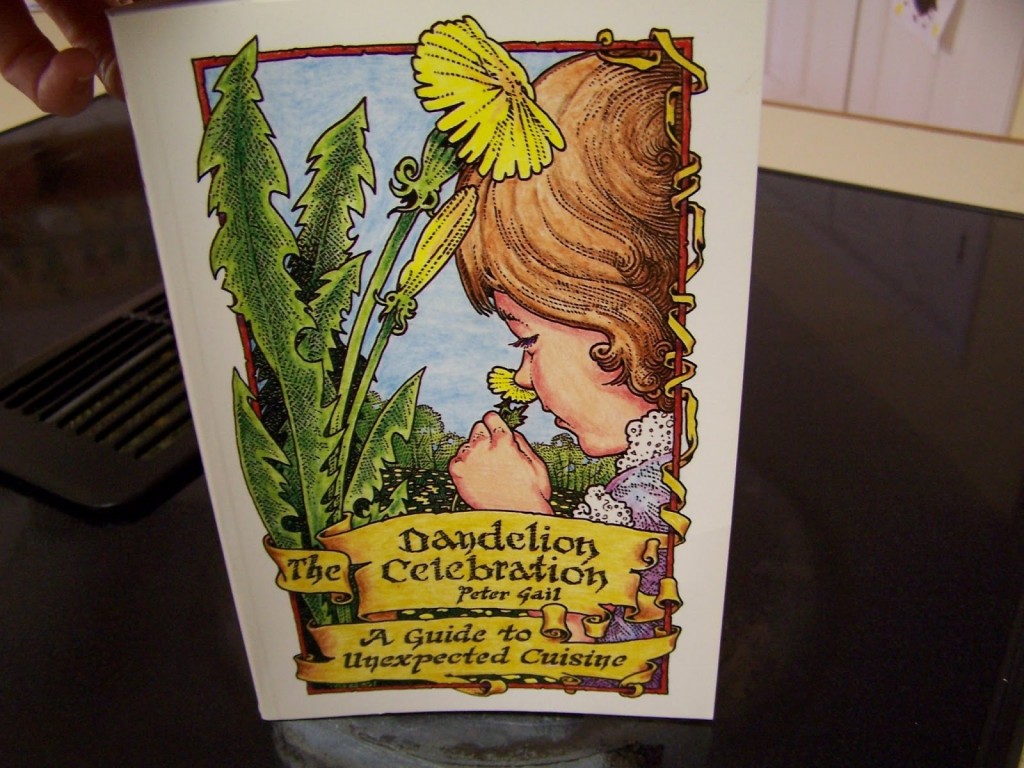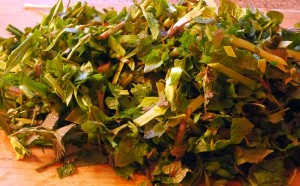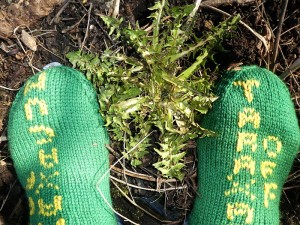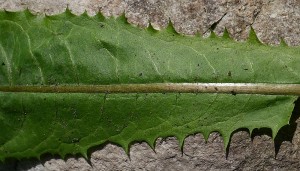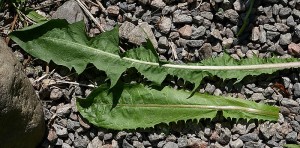Tonight’s 22 greens from the garden with yacon used in a quinoa stir-fry (with garlic and chili in addition):
Brassica oleracea (perennial kale / flerårig kål)
Hydrophyllum virginianum (waterleaf, indian salad)
Tragopogon pratensis (Jack-go-to-bed-at-noon / geitskjegg)
Angelica spp. (kvann)
Allium carinatum
Allium ursinum (ramsons / ramsløk)
Primula elatior (oxlip / hagenøkleblom)
Hablitzia tamnoides (Caucasian spinach / stjernemelde)
Carum carvi (caraway / karve)
Myrrhis odorata (sweet cicely / spansk kjørvel)
Polymnia edulis (yacon)
Urtica dioica ( stinging nettle / brennesle)
Campanula latifolia (giant bellflower / storklokke)
Ficaria verna (lesser celandine / vårkål)
Rumex acetosa (sorrel / engsyre)
Dystaenia takesimana (giant Ulleung celery)
Hemerocallis spp. (day lily / daglilje)
Taraxacum spp. (dandelion / løvetann)
Rheum ribes
Armoracia rusticana (horseradish / pepperrot)
Allium nutans
Aegopodium podograria (ground elder / skvallerkål)

Tag Archives: Taraxacum
Slowly Approaching the time of Plenty: Spring!
Tonight’s sourdough pizza greens, all harvested outside after most of the snow disappeared during the day. From the top and clockwise; Ficaria verna (lesser celandine / vårkål), Allium cernuum (nodding onion / prærieløk), Hablitzia tamnoides (Caucasian spinach / stjernemelde), Allium carinatum, Allium senescens (or hybrid), Primula veris (cowslip / marianøkleblom), Alliaria petiolata (garlic mustard / løkurt) and Taraxacum spp. (dandelion / løvetann)
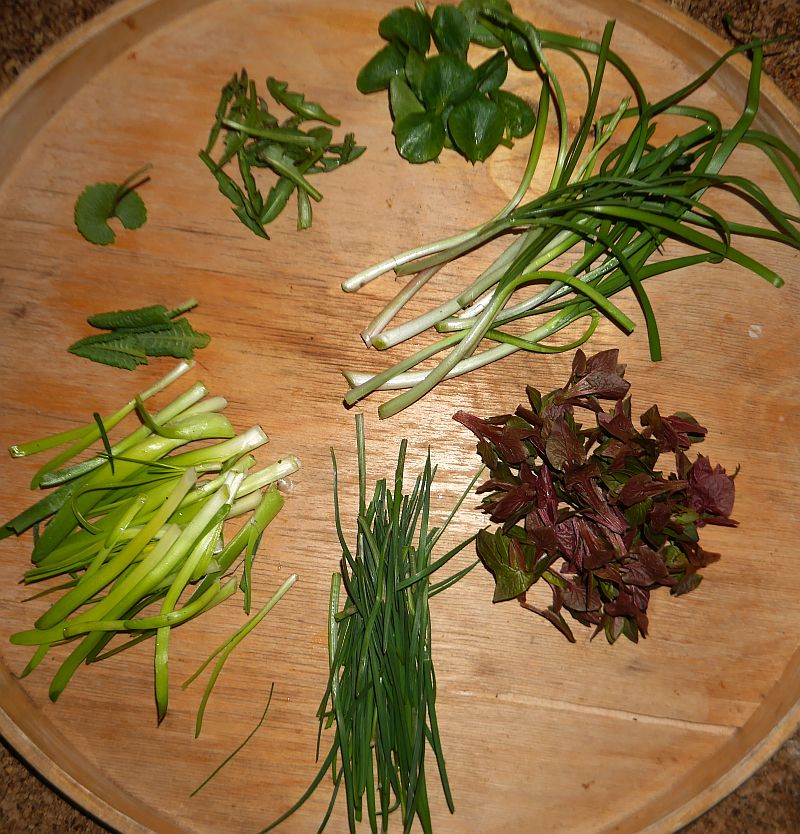
Sprouts in the cellar
A much warmer winter than normal and I returned home to well developed blanched dandelion shoots in the cellar together with horseradish shoots and the sweet cicely shoots (Myrrhis odorata) had also germinated en masse!
This post shows the dandelion roots being dug and planted at the end of November: http://www.edimentals.com/blog/?p=23997

Dandelion 
Horseradish 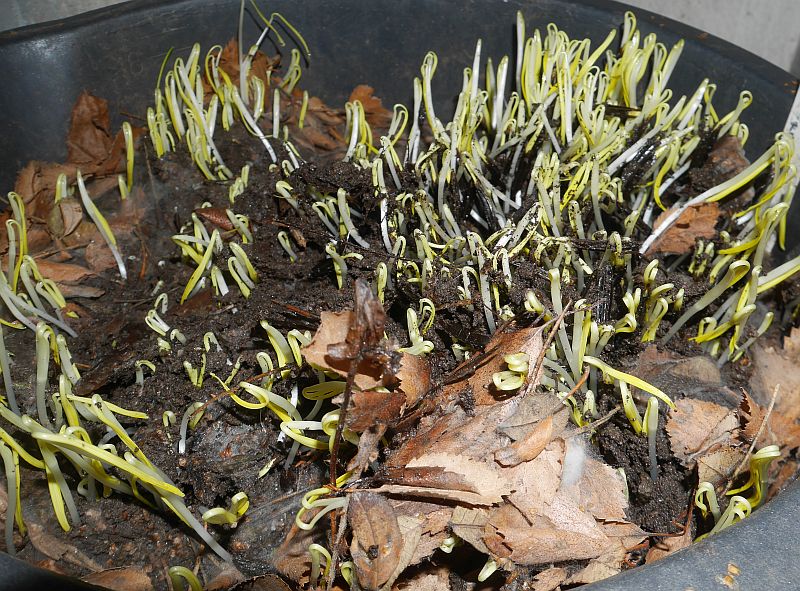
Myrrhis odorata (sweet cicely)
More blanched dandelions
RIP The King of the Dandelions, Dandelion Dude Peter Gail
Excerpt from Around the World in 80 plants:
“I eventually saw the light (about eating dandelions”when I followed a discussion on the ForageAhead email group between two of North
America’s leading foragers ‘Dandelion Dude’ Peter Gail and John Kallas. Gail has written several essays and books about dandelions including his Dandelion Celebration (1994). He also founded the group ‘Defenders of Dandelions’ to provide information to those who want to make their neighbours aware just how good dandelions are and stop the chemical warfare. He has also organised the National Dandelion Cookoff in Dover, Ohio, still going strong since 1993. Gail says he ate dandelions every day, fresh in the summer and in dehydrated form in winter, growing his own from transplanted wild roots on raised beds in his garden for ease of access. Gail has been rightly coined the King of the Dandelions! However, it was John Kallas’ web essay Making Dandelions Palatable that explains how such a bitter weed could be so popular around the world. To start with, Gail admits to thinking he was being poisoned the first time he ate dandelion and Kallas also found them very bitter, but was determined to solve the riddle. He first points out that foraging books downplay the bitterness and thinks that the oft-quoted difference between the first mild leaves in spring and bitter at flowering time is also exaggerated. As a result many people are
disappointed and permanently put off when they sample their first dandelion. I was with him here … He says that as part of his PhD he interviewed old timers in rural Michigan. Dandelions were the most common wild collected food in this group and, no, they weren’t bitter, they said. Upon asking how they prepared the dandelions they explained that the fresh leaves were mixed with bacon grease, bacon, eggs, salt and sometimes vinegar. Incidentally, salade de pissenlit et lardons (salad of dandelion and bacon) is still prepared in France today. In most cultures as you can see in the around-the-world review above, dandelions are almost never eaten fresh alone.”
2nd May Abundance
Taraxocks ;)
Longest dandelion leaf?
Norwegian sansai
From top left, left to right: Angelica archangelica “Vossakvann”, various dandelions / løvetann (Taraxacum), Rumex patientia (patience dock/hagesyre), Garlic bulbil shoots (forced indoors), ground elder / skvallerkål, Rheum palmatum (petiole), Rumex acetosa (sorrel / engsyre), Myrrhis odorata (with root ; sweet cicely / spansk kjørvel), chervil / hagekjørvel, Campanula latifolia (giant bellflower / storklokke), horseradish / pepperrot ( shoot), Anredera cordifolia (Madeira vine; grown inside), Alliaria petiolata ( garlic mustard / løkurt), Hemerocallis (daylily/daglilje), Ranunculus ficaria (lesser celandine / vårkål), Urtica dioica (nettle / nesle), Allium senescens x nutans, Hablitzia tamnoides (Hablitzia, Caucasian spinach / stjernemelde)…made into a stir fry with soba (buckwheat pasta)

